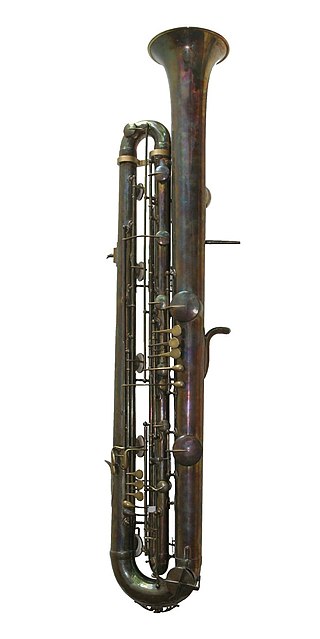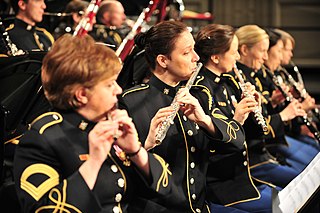
The clarinet is a musical instrument in the woodwind family. The instrument has a nearly cylindrical bore and a flared bell, and uses a single reed to produce sound.

The saxophone is a type of single-reed woodwind instrument with a conical body, usually made of brass. As with all single-reed instruments, sound is produced when a reed on a mouthpiece vibrates to produce a sound wave inside the instrument's body. The pitch is controlled by opening and closing holes in the body to change the effective length of the tube. The holes are closed by leather pads attached to keys operated by the player. Saxophones are made in various sizes and are almost always treated as transposing instruments. Saxophone players are called saxophonists.

Woodwind instruments are a family of musical instruments within the greater category of wind instruments. Common examples include flute, clarinet, oboe, bassoon, and saxophone. There are two main types of woodwind instruments: flutes and reed instruments. The main distinction between these instruments and other wind instruments is the way in which they produce sound. All woodwinds produce sound by splitting the air blown into them on a sharp edge, such as a reed or a fipple. Despite the name, a woodwind may be made of any material, not just wood. Common examples include brass, silver, cane, as well as other metals such as gold and platinum. The saxophone, for example, though made of brass, is considered a woodwind because it requires a reed to produce sound. Occasionally, woodwinds are made of earthen materials, especially ocarinas.

A reed is a thin strip of material that vibrates to produce a sound on a musical instrument. Most woodwind instrument reeds are made from Arundo donax or synthetic material. Tuned reeds are made of metal or synthetics. Musical instruments are classified according to the type and number of reeds.

In organology, the study of musical instruments, many methods of classifying instruments exist. Most methods are specific to a particular cultural group and were developed to serve that culture's musical needs. Culture-based classification methods sometimes break down when applied outside that culture. For example, a classification based on instrument use may fail when applied to another culture that uses the same instrument differently.

The sarrusophones are a family of metal double reed conical bore woodwind instruments patented and first manufactured by Pierre-Louis Gautrot in 1856. Gautrot named the sarrusophone after French bandmaster Pierre-Auguste Sarrus (1813–1876), whom he credited with the concept of the instrument, though it is not clear whether Sarrus benefited financially. The instruments were intended for military bands, to serve as replacements for oboes and bassoons which at the time lacked the carrying power required for outdoor marching music. Although originally designed as double-reed instruments, single-reed mouthpieces were later developed that could be used for the larger bass and contrabass sarrusophones.
Hornbostel–Sachs or Sachs–Hornbostel is a system of musical instrument classification devised by Erich Moritz von Hornbostel and Curt Sachs, and first published in the Zeitschrift für Ethnologie in 1914. An English translation was published in the Galpin Society Journal in 1961. It is the most widely used system for classifying musical instruments by ethnomusicologists and organologists. The system was updated in 2011 as part of the work of the Musical Instrument Museums Online (MIMO) Project.

An aerophone is a musical instrument that produces sound primarily by causing a body of air to vibrate, without the use of strings or membranes, and without the vibration of the instrument itself adding considerably to the sound.
Overblowing is the manipulation of supplied air through a wind instrument that causes the sounded pitch to jump to a higher one without a fingering change or the operation of a slide. Overblowing may involve a change in the air pressure, in the point at which the air is directed, or in the resonance characteristics of the chamber formed by the mouth and throat of the player.
Contrabass refers to several musical instruments of very low pitch—generally one octave below bass register instruments. While the term most commonly refers to the double bass, many other instruments in the contrabass register exist.

The tenor saxophone is a medium-sized member of the saxophone family, a group of instruments invented by Adolphe Sax in the 1840s. The tenor and the alto are the two most commonly used saxophones. The tenor is pitched in the key of B♭ (while the alto is pitched in the key of E♭), and written as a transposing instrument in the treble clef, sounding an octave and a major second lower than the written pitch. Modern tenor saxophones which have a high F♯ key have a range from A♭2 to E5 (concert) and are therefore pitched one octave below the soprano saxophone. People who play the tenor saxophone are known as "tenor saxophonists", "tenor sax players", or "saxophonists".

The bassanello was a Renaissance double reed woodwind instrument which was described in 1619 by Michael Praetorius in his Syntagma Musicum II:

A single-reed instrument is a woodwind instrument that uses only one reed to produce sound. The very earliest single-reed instruments were documented in ancient Egypt, as well as the Middle East, Greece, and the Roman Empire. The earliest types of single-reed instruments used idioglottal reeds, where the vibrating reed is a tongue cut and shaped on the tube of cane. Much later, single-reed instruments started using heteroglottal reeds, where a reed is cut and separated from the tube of cane and attached to a mouthpiece of some sort. By contrast, in a double reed instrument, there is no mouthpiece; the two parts of the reed vibrate against one another. Reeds are traditionally made of cane and produce sound when air is blown across or through them. The type of instruments that use a single reed are clarinets and saxophone. The timbre of a single and double reed instrument is related to the harmonic series caused by the shape of the corpus. E.g. the clarinet is only including the odd harmonics due to air column modes canceling out the even harmonics. This may be compared to the timbre of a square wave.

The contrabass sarrusophone is the deepest of the family of sarrusophones, and was made in three sizes. It was made in the 19th and early 20th centuries, primarily in Europe by Gautrot, Couesnon, Romeo Orsi, Rampone, and Evette & Schaeffer, and in the United States by Conn, who built instruments in E♭ for US military bands.

The heckel-clarina, also known as clarina or patent clarina, is a very rare woodwind instrument, invented and manufactured by Wilhelm Heckel in Wiesbaden-Biebrich, Germany. Heckel received a patent for the instrument on 8 December 1889. It was apparently intended to be used for the shepherd’s pipe solo in Act III of Wagner's Tristan und Isolde. It was used beginning in 1891 at the Festspielhaus, Bayreuth as a substitute for Wagner's Holztrompete; the clarina was found more practical and more effective in producing the desired tone-colour.

The clarinet family is a musical instrument family of various sizes and types of clarinets, including the well-known B♭ clarinet, the bass clarinet, and the slightly less familiar E♭ and A clarinets among others.

The woodwind section, which consists of woodwind instruments, is one of the main sections of an orchestra or concert band. Woodwind sections contain instruments given Hornbostel-Sachs classifications of 421 and 422, but exclude 423












